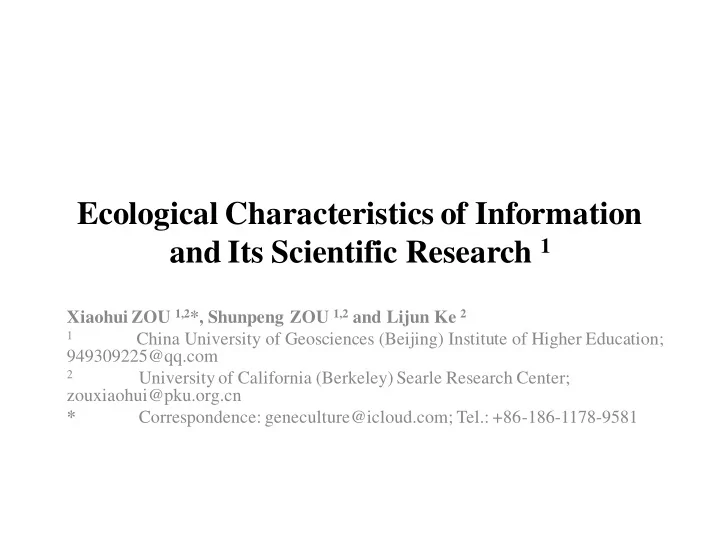

Ecological Characteristics of Information and Its Scientific Research 1 Xiaohui ZOU 1,2 *, Shunpeng ZOU 1,2 and Lijun Ke 2 1 China University of Geosciences (Beijing) Institute of Higher Education; 949309225@qq.com 2 University of California (Berkeley) Searle Research Center; zouxiaohui@pku.org.cn * Correspondence: geneculture@icloud.com; Tel.: +86-186-1178-9581
Abstract • This paper aims to explore the ecological characteristics of information and its scientific research from various aspects. The method is: Firstly, it explores formal information including eight basic types, and then explores the essence of information involved the logic of position and order or sequence. Finally, it reveals the ecological characteristics of information ontology related to terminology framework and conceptual system, which is characterized by not only the ambiguity of formal semantics and formal information can be automatically identified and eliminated in the computer-aided information processing environment, but also the ambiguity of the content semantics and content information, can pass through language chessboard and knowledge chess game, with essential information and ontological information, to resolve ambiguity. The result is that the basic law of information and its existence is highlighted, and the social and ecological characteristics of information science research are embodied by macro models (ideas and methods) and micro models (Chinese chessboard and English chessboard). Its significance is information ecology and its supporting methodology, formalization and method system to obtain a new breakthrough, specifically for the classification of information phenomenon and attribution on the determination of its scientific basis, which is conducive to the timely identification and resolution of various ambiguities.
Keywords • formal information • essential information • ontological information • information ecology
1. Introduction • This paper aims to explore ecological characteristics of information and its scientific research from various aspects. • Grammatical information [1] , semantic information [2] and pragmatic information [3] all can be further divided into content information [4] and formal information [5][6][7] [8][9][10] . There is a very rich connotation [11] and extension [12] among them. It is not an exaggeration to call information ecology [13] . So how to recognize or to characterize them is the key to the ecological aspects of information. This paper uses the phenomenon of information [14] , the nature or essence of information [15] and the ontology of information [16] as three basic perspectives to understand or to operate the three series of information ecology systematically.
2. Materials or Knowledge Background • 2.1. The prelude of formal informatics • If Tarski's division of object language and meta-language is the beginning of formal informatics, then Turing's calculation or computing of formal information with Shannon's Statistical Analysis of formal information is the sign of formal informatics. • 2.2. The prelude of Content Informatics • If Feigenbaum's analysis or calculation of the content information is the beginning of content informatics as knowledge engineering, then Yixin Zhong’s thinking systematically on the grammatical information, the semantic information and the pragmatic information is the content of information science to start. The question now is: how to resolve the ambiguities?
3. Methods 3.1. The Phenomenon of Information • Figure 1 is our view of generalized text and its two standard systems
3.2. The Essence of Information • Figure 2 is English formal information processing namely micro-chessboards as an example
3.2. The Essence of Information • Figure 3 is Chinese formal information processing namely mini-chessboards as an example
3. Methods 3. 3. The Ontology of Information • Figure 4 is English information processing namely micro-knowledge chess-menu as an example
3. 3. The Ontology of Information • Figure 5 is Chinese formal information processing namely micro-knowledge chess-menu as an example
4. Results • Figure 6 are Basic models of ambiguity analysis: • (a) model of basic views; (b) model of basic methods.
5. Discussion &6. Conclusions • Figure 7 Shows three equations with twin chess-board based on Z-ASCII system
References • 1. Shannon. A mathematical theory of communication. Bell System Technical Journal.1948 • 2. Tarski. Surles ensembles définissables de nombres réels. Fundamenta Mathematica.1931 • 3. Wiener. Cybernetics or Control and Communication in the Animal and the Machines.1961 • 4. Yixin,ZHONG. Comprehensive Information Based Methodology for Natural Language Understanding. Journal of Beijing University of Posts and Telecommunications. 2004, 27(4) • 5. Turing.Computing Machinery and Intelligence.Mind.1950 • 6. Chomsky.Syntactic structures.1957 • 7. John McCarthy,Marvin Minsky,Nathaniel Rochester,Claude E. Shannon. A Proposal for the Dartmouth Summer Research Project on Artificial Intelligence, August 31, 1955. • 8. Feigenbaum. The Art of Artificial Intelligence: Themes and Case Studies in Knowledge Engineering. Proceedings of the 5th International Joint Conference on Artificial Intelligence - Volume 2. 1977 • 9. Carnap.Introduction to Semantics and Formalization of Logic.1975 • 冯志伟 (Zhiwei,Feng). 自然语言计算机形式分析的理论与方法 (Theory and Method for Formal Analysis of Natural Language by Computer). 中国科学技术 10. 大学出版社 (China University of Science and Technology Press).2017.1 • 11. Yixin,ZHONG.Structuralism? Functionalism?Behhaviorism?or Mechanism? Looking for a better approach to AI. International Journal of Intelligent Computing and Cybernetics.2008 • 邹晓辉 (Xiaohui, ZOU). 理性的标准的协同智能模型 (Rational Standard Cooperating Intelligent Model). 前沿科学 (Leading Science). 2005 12. • 邹晓辉 (Xiaohui, ZOU). 信息学基础研究 (Fundamental Research of Informatics). 信息科学交叉研究 (Information Science Inter- disciplinary Research by 13. Ainai, MA; Dongsheng, MIAO; Lu,JIANG; Xueshan,YAN). 2007 • 钟义信 (Yixin,ZHONG). 信息转换原理 : 信息、知识、智能的一体化理论 (Information conversion principle: information, knowledge, intelligent integration 14. theory). 科学通报 (Science Bulletin).2013(14) • 15. Floridi.Semantic Conceptions of Information.Stanford Encyclopedia of Philosophy .2014 • 16. Searle. Minds, Brains and Programs. Behavioral and Brain Sciences .1980
Appendix • Appendix A http://kben.koderx.com/article/3/board http://kben.koderx.com/article/3/group Appendix B http://kb2.sloud.cn/article/51/board http://kb2.sloud.cn/article/51/group
FUNDAMENTAL LAW OF INFORMATION: PROVED BY DOUBLE MATRICES ON NUMBERS AND CHARACTERS https://aaas.confex.com/aaas/2017/poster/papers/viewonly.cgi?password=653376&username=20463
FORMAL BILINGUAL CHESSBOARD SPECTRUM : SHOW THE OVERLAPPING BETWEEN LANGUAGE AND MIND https://aaas.confex.com/aaas/2017/poster/papers/viewonly.cgi?password=379336&username=19708
Recommend
More recommend